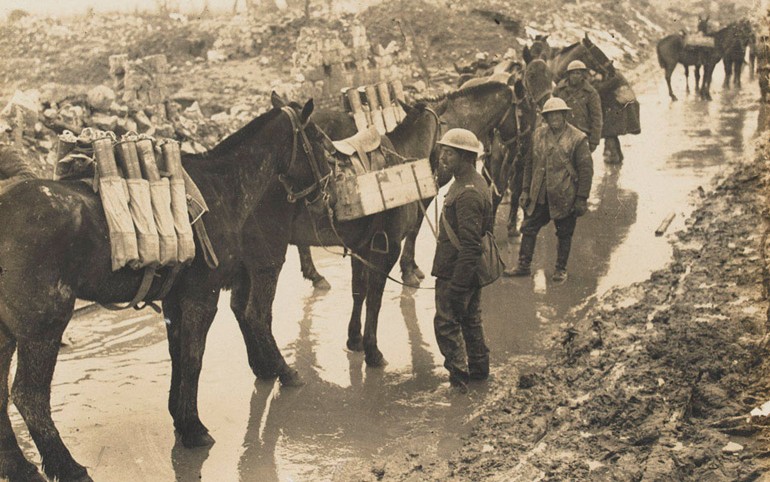Dogs with first-aid and stimulants off to find wounded in inaccessible parts of no-man’s land, c1915
More details: NAM. 1977-11-228-56
Throughout the First World War, animals were heavily relied upon by the British Army. From cavalry to communication, we take a look at how they contributed to the war effort and the vital role they played in helping our troops.
When it came to tactics and equipment, the First World War was a conflict of contrasts. On the one hand, it led to great advances in weaponry, such as more effective aircraft, tanks and artillery. On the other, the use of traditional resources continued on a vast scale. Animals, for example, were as indispensible as their technological comrades in the fight for victory.
Many animals were used by the British Army during the First World War. Horses, for example, are an iconic symbol of the conflict, thanks in part to the hugely popular Michael Morpurgo novel, War Horse. In our online exhibition War Horse: Fact & Fiction, we explore in-depth how the role of horses developed from 1914 to 1918, evolving from a key role as cavalry on the front line at the start of the War, to one integral to the transportation of food and supplies later on.
The terrifying might of machine guns proved more effective than the speed and agility of horses in the static battles of 1915 onwards. However, there was no technology to match their unique ability to cross the deep mud and craters in no-man’s land.
The Army continued to depend on horses, as well as mules and donkeys, for the delivery of key supplies, acquiring nearly half a million steeds by 1918. They helped distribute nearly 80,000 tons of food to soldiers and civilians all over the globe.
As well as transport and supplies, animals were used for fast and effective communication. Carrier pigeons, for example, were believed to be a faster and safer method of communication than telephone. They were also employed by ships and submarines to send messages in case of sinking.
Dogs, too, were trained to deliver messages between the front lines and reserves, being able to run much faster than their human counterparts and negotiate particularly tricky terrain.
As well as canine communication, dogs were trained to deliver first-aid to soldiers stuck in the mud of no-man’s land. After heavy fighting, they were sent out into the field by their handlers in the Royal Army Medical Corps with key supplies, such as stimulants and bandages, to give desperate men a chance to stabilise their wounds before medics could reach them, or so that they could make their own way back to British lines.
Like their human comrades, animals suffered greatly in the tough conditions of war. Thousands were lost to disease, starvation and exhaustion – as well as enemy attacks.
To pay tribute and remember the acts of bravery that these animals performed, a number of memorials now stand in Britain, including The Animals Memorial at Brook Gate, Hyde Park, London.
 First World War in Focus
First World War in Focus




